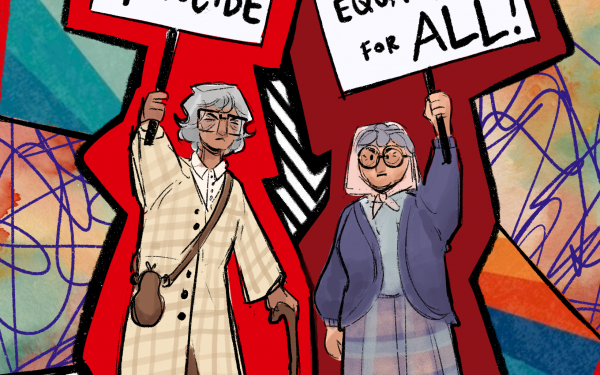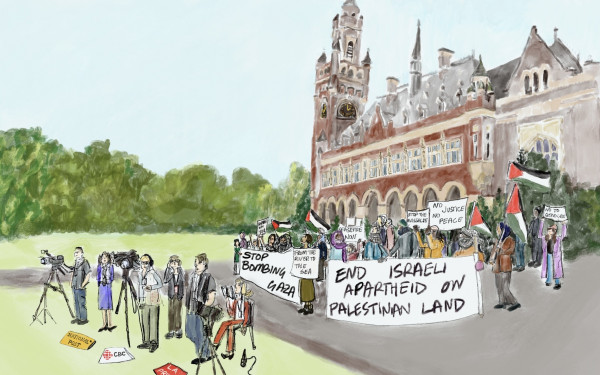The media is distorting global perspectives on Gaza
Legacy media spoon feeds us bias and it is unsettling
Families are being torn apart, children being starved and nearly the entire population of Gaza is uprooted. In a region gripped by turmoil, the human suffering in Gaza is profound.
Oct. 7, 2024, marked one year of the ongoing genocide in Gaza.
The United Nations reports approximately 42,000 Palestinian fatalities; 496,000 Palestinians who face catastrophic levels of food insecurity; and 1.9 million internally displaced persons, amounting to 90 per cent of Gaza.
Despite evidence from journalists on the ground, Western media coverage has often been biased and incomplete.
Factual reporting is crucial for shaping global awareness, influencing international response and ensuring effective humanitarian aid during crises. Since media outlets serve as the predominant bridge between global crises and local understanding, the narratives we consume can significantly warp our perspective on reality, including the genocide in Gaza.
Western networks such as BBC often emphasize Israeli security, while networks like Al Jazeera focus on Palestinian plight. This disparity results in a pro-Israel bias in U.S. coverage, as shown in an analysis of major U.S. newspapers conducted by Adam Johnson and Othman Ali for The Intercept. The results of the quantitative analysis showed that references to Israel outnumbered those of Palestinian victims in the first six weeks of the Gaza genocide.
The analysis also found that “Israeli” or “Israel” appeared more frequently than “Palestinian” in print media outlets like The New York Times, The Washington Post and the Los Angeles Times. In addition, language such as “slaughter,” “massacre” and “horrific” were reserved for describing attacks on Israeli civilians, while the deaths of Palestinian children were framed passively with terms like “left to die.”
This framing downplays the perpetrator's role, implying no responsibility for the killings. The dehumanizing language is particularly evident in the way that deaths are reported.
“Israel marked a month since Hamas killed 1,400 people and kidnapped 240, starting a war in which 10,300 Palestinians are said to have died,” stated The Times of London in early November. The language used in this sentence emphasizes that Israel “marked a month since Hamas killed 1,400 people.”
In contrast, it describes Palestinian casualties passively with, “said to have died.” This subtle bias can make Israeli losses seem more intentional and Palestinians as less certain and direct.
The media has shown its partiality on multiple occasions. Between Oct. 7 and Nov. 25, a period during which Israeli forces killed 6,000 children in Gaza, only two articles out of over 1,100 published in the three major U.S. newspapers mentioned the murders.
Another analysis of U.S. cable news coverage in the first month of the genocide showed that, ironically, the spokesperson for the Israel Defense Forces appeared 44 times on CNN, MSNBC and Fox News. Additionally, Israelis were mentioned four times more than Palestinians, despite Palestinian deaths outnumbering Israeli ones.
When the media fails to present balanced coverage, the distinction between what is true and false blurs, further dividing and distorting public perception. The media’s choice of language reflects deep systemic biases.
Media coverage plays a pivotal role in shaping governmental and organizational responses to crises. When the media displays suffering, it generates international outcry, pressuring governments to prioritize aid.
Early in the genocide, the increased media focus on Israel’s airstrikes temporarily heightened international awareness and mobilized humanitarian aid. However, as the narrative shifted and became selective, the call for urgent aid was reduced.
The humanitarian situation in Gaza is worsening, with extreme shortages of food, medicine and electricity, causing the suffering of millions. A report by the Integrated Food Security Phase Classification estimated that over 90 percent of the population is experiencing crisis levels of food insecurity. Gaza’s healthcare system is also collapsing due to ongoing Israeli attacks.
The emergence of citizen journalism has reshaped reporting, offering diverse viewpoints that the traditional media often overlooks. Social media has allowed Palestinians to share their lived experiences, exposing the harsh realities they face.
Platforms like Instagram, Tikok and Twitter have become lifelines for Palestinians, documenting their experiences in the immediate aftermath of airstrikes.
Viral hashtags such as #GazaUnderAttack and #FreePalestine trended internationally, raising awareness that humanized the Palestinian struggle. These platforms have become foundations for civilians, press journalists and activists to share live footage, evading the gatekeeping nature of traditional media.
The gruesome images shared on social media have directly impacted international calls for a ceasefire and humanitarian aid, revolutionizing how conflicts are reported.
The media holds substantial power in shaping global understanding and responses to humanitarian crises.
In Gaza, biased and limited reported has affected awareness of the ongoing genocide.
We must evaluate the media and call for thorough, accurate coverage to uplift silenced voices and drive global action.
This article originally appeared in Volume 45, Issue 5, published November 5, 2024.


_600_832_s.png)




